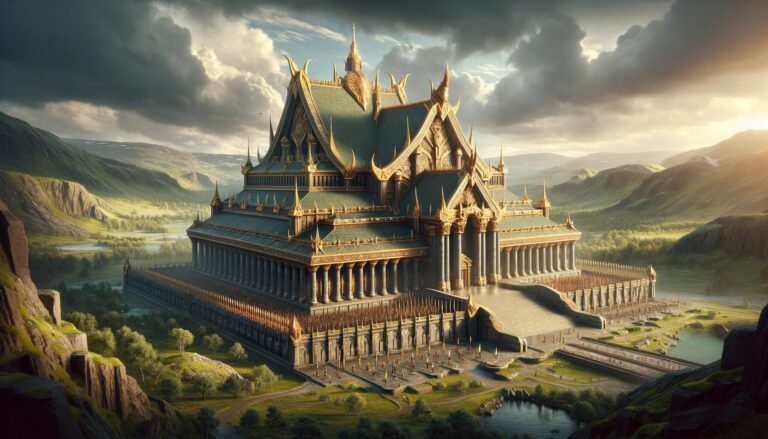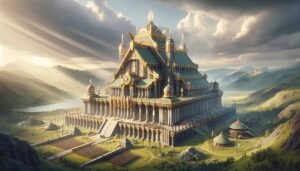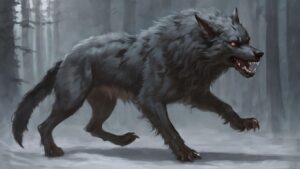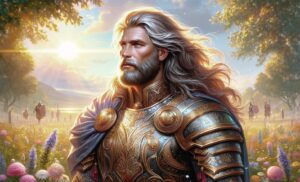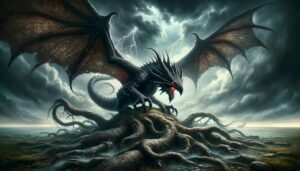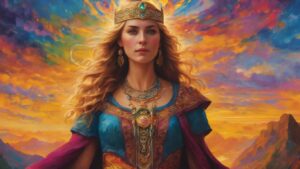Table of Contents
In Norse mythology, Valkyries, female figures who serve Odin, the chief of the gods, choose brave warriors who die in battle and guide them to Valhalla, a hall in the afterlife. These warriors join the ranks of the einherjar (chosen warriors) to prepare for Ragnarok, the final battle. Those who die differently, like from illness or old age, might go to other afterlife realms, such as Hel or Fólkvangr, depending on various factors and interpretations.
What Is Valhalla
Valhalla, where the most noble of fallen warriors dwell in the company of Odin, stands as a realm of eternal glory. People believe that only the bravest and most skilled individuals are chosen to reside in this opulent paradise. Valhalla’s renown extends to its abundance of food and drink, with mead and meat being the favored indulgences of warriors. Every detail within Valhalla meticulously caters to the needs of these fearless champions in their afterlife.
How Were the Admissions to Valhalla Determined
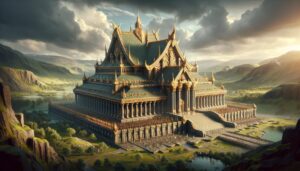
Valhalla held a sacred and honorable status for afterlife admission. Over time, debates ensued about the criteria, with a prevailing belief that a violent death was required. For years, people assumed that simply dying at another’s hands or perishing in a struggle ensured Valhalla entry. However, Baldur’s death story refuted this notion.
Another belief was that warriors could gain entry to Valhalla. Yet, there were accounts of warriors who, despite dying in battle, were not admitted. This suggests that Odin had the final say in selecting the einherjar, requiring a certain quality in those chosen to aid him in the impending battle against Fenrir during Ragnarök.
Who Were the Einherjar
The einherjar were known as the elite warriors who had met noble deaths, granting them passage to Valhalla. The term “einherjar” translates to “fights alone” or “fighting alone,” reflecting the formidable nature of these men and their capacity to hold their own in battle. This quality was particularly significant as they would be expected to fight valiantly in Ragnarök.
Did Odin Influence the Outcomes of Battles?
It was a common belief that Odin and the Valkyries observed battles and predetermined their outcomes even before the fighting commenced. The Valkyries, often described as beautiful female spirits, played a role in choosing the victors and the fallen. Their name, “the choosers of the fallen,” indicates this dual function. Odin and the Valkyries wove the fate of those on the battlefield using human intestines, heads as weights, and swords as beaters.
After a battle concluded, Odin and the Valkyries would select half of the warriors left behind. These chosen ones were usually the most skilled and elite, worthy to stand with Odin in the final battle of Ragnarök. The other half of the warriors were claimed by Freya.
What Does Valhalla Look Like?
Valhalla’s description is a captivating aspect of its tale. This grand hall is situated within the realm of Asgard and is known for its ornate beauty. The hall boasts a roof adorned with golden shields that gleam like the sun, while its interior features grand feasting tables and mead-filled drinking horns, creating an atmosphere of perpetual celebration.
Beyond Valhalla, there lies a golden tree called Glasir, considered one of the most exquisite creations. Moreover, nearby, a goat named Heiorun and a stag named Eikthyrnir graze on a tree called Laeraor. Both of these magnificent creatures play crucial roles in Valhalla’s sustenance. Notably, Heiorun produces an endless supply of mead, a favorite indulgence of the einherjar. Additionally, Eikthyrnir’s antlers continuously drip liquid into a spring known as Hvergelmir, believed to be the source of all waters.
Furthermore, a boar named Saehrimnir, remarkable for its size and regenerative ability, serves as the primary sustenance for the noble warriors inhabiting Valhalla. It is roasted daily to feed the einherjar, and remarkably, it fully reconstitutes itself by the nightfall, ensuring an uninterrupted supply of nourishment.
Inside Valhalla
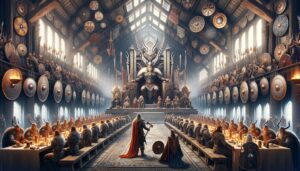
Entering Valhalla offers a truly breathtaking experience. Within these hallowed halls, Odin presides alongside his honored fallen warriors and the elegant Valkyries. Furthermore, the fortress itself stands as a colossal structure, boasting a roof adorned with shields and spears that form the imposing rafters high above. In the main hall, the noble warriors gather, and within this grandeur, three thrones take prominence. ‘High’ occupies the lowest throne, ‘Just as High’ sits in the middle, and ‘Third’ claims the tallest throne, but it is ‘High’ who holds the kingship within this revered realm.
Valkyries play a crucial role, serving the warriors they escorted to Valhalla and aiding them in their preparations for Ragnarök. Dining tables and chairs, constructed from fine breastplates and armor, fill the hall. Bright and gleaming swords provide ambient light, and decorative shields adorn the walls. Within Valhalla, multiple rooms exist, such as Thor’s hall, Bilskirnir, boasting an astounding 540 rooms.
A Typical Day in Valhalla
Valhalla maintains an environment of perpetual warfare. It houses the finest and fiercest warriors, handpicked by Odin. Their daily routine consists of combat training, where they engage in fights, perform noble deeds, and sustain wounds to keep their reflexes sharp. Remarkably, all injuries heal by the end of the day.
In the early morning, Odin dispatches his ravens, Huginn and Muninn, to observe the world. This marks the warriors’ cue to begin their day. They participate in sporting games, battles, and other activities, honing their skills for the impending Ragnarök.
Throughout the day, the einherjar engage in constant combat. They fight each other and perform heroic acts, their bodies mirroring the wounds of their human lives. As evening descends, their injuries are magically healed.
Feasting in Valhalla is a grand affair. Saehrimnir provides meat, Heiorun offers mead, and Valkyries serve, facilitating night-long celebrations. Notably, Odin refrains from eating but indulges in wine. He allocates his portion of meat to his wolves, Geri and Freki. By dawn, Saehrimnir is resurrected, and the warriors rest, ready for the next day’s adventures.
Viking Practices Associated with Valhalla
The Norse people held a deep reverence for Valhalla, and various aspects of Viking life were connected to their pursuit of safe passage to this warrior’s paradise.
Sacrificing Enemies: Vikings sought to appease Odin by offering human sacrifices, especially those of enemy nobility and armies. These sacrifices, typically involving spears and nooses, aimed to garner Odin’s favor.
Battle Magic and the Ulfehonar: The Ulfehonar, known as wolf warriors, pledged allegiance to Odin and constituted many of the einherjar admitted to Valhalla. They practiced shamanic traditions that allowed them to embody the spirit of animals, enhancing their battle prowess. Berserkers (bear warriors) and Svinfylking (boar warriors) shared similar shamanic warrior practices.
Burial Rites: Vikings believed that burning the deceased on a funeral pyre atop a burial mound, along with their possessions, would facilitate their journey to Valhalla. This allowed them to take their favorite weapons and possessions with them to the afterlife.
Myths
Numerous myths and verses recount Valhalla’s splendor and its inhabitants, offering insights into this revered place in Norse culture.
Helgi Hundingsbane Enters Valhalla: The hero Helgi, known as Hundingsbane, secures a place in Valhalla after a life of valorous deeds, including defeating King Hunding. His love for the Valkyrie Sigrun and their journey in both life and death add depth to his myth.
King Gylfi Searches for the Power of the Gods in Valhalla: King Gylfi, traveling incognito as Gangleri, embarks on a quest to uncover the gods’ power in Asgard. His encounter with Valhalla reveals its grandeur and Odin’s role in the hall.
Hrungnir Fights Thor: Hrungnir, a jötunn, challenges Odin’s authority within Valhalla, leading to a fateful confrontation with Thor. This myth demonstrates the fierce protection of Valhalla by the gods.
Who is in Valhalla ?
In Norse mythology, some famous gods and figures who are believed to reside in Valhalla include:
Odin (Allfather): The chief of the Norse gods.
Thor: The god of thunder and one of the most famous Norse deities.
Loki: A trickster god who is sometimes counted among the inhabitants of Valhalla.
Tyr: The god of law and heroic glory.
Freyja: A goddess associated with love, fertility, and war.
Freyr: Freyja’s brother, associated with prosperity and peace.
Baldur: A beloved god of light and purity.
Heimdall: The guardian of the Bifrost, the rainbow bridge to Asgard.
Skáldskaparmál: A legendary figure associated with poetry and storytelling.
Various heroic warriors: Valhalla is primarily known for hosting brave warriors who died in battle and were chosen by the Valkyries.
These are just a few of the gods and individuals commonly associated with Valhalla in Norse mythology. The concept of who resides in Valhalla can vary in different sources and interpretations of the mythology.
FAQ
Who selects warriors for Valhalla?
Valkyries, female figures, choose and guide warriors to Valhalla.
What do warriors do in Valhalla?
They join the einherjar to prepare for Ragnarok, the final battle.
What happens to those who die differently?
They may go to other afterlife realms, like Hel or Fólkvangr, depending on various factors.
Who is the chief god associated with Valhalla?
Odin, the chief of the Norse gods, is linked to Valhalla.
What is the purpose of Valhalla?
It's a reward for heroic warriors and a gathering place for warriors.
Are there other afterlife realms in Norse mythology?
Yes, Hel and Fólkvangr are among other realms.
